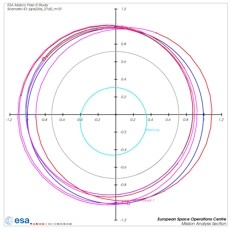Mission Operations
- Launch and early operations
- Cruise to the asteroid
-
Asteroid proximity operations:
- Far approach and asteroid characterization
- Radio science phase, during which the detailed gravity field is accurately determined
- Global characterization, during which the complete asteroid is characterized and up to five safe and scientifically valuable potential sampling sites are selected
- Local characterization phase, during which the potential sampling sites are analysed in more detail
- Sampling rehearsals, enabling validation of the descent and touchdown approach
- Sampling attempts (up to three) from the selected site
- Local characterization post-sampling to understand the impact of the sampling on the actual surface
- Schedule margins
- Return to Earth
- Jettisoning of the Earth re-entry capsule (ERC)
- Capsule re-entry and recovery
- Transfer of the sample container to the curation facility where it will be protected and divided into samples
- Distribution of the samples to laboratories for analysis
Mission operations for MarcoPolo-R will be established in a manner similar to those of ongoing ESA planetary missions. A Mission Operations Centre (MOC) at the European Space Operations Centre (ESOC) in Germany would be in charge of routine spacecraft operations, while the Science Ground Segment (SGS) located at the European Space Astronomy Centre (ESAC) in Spain would coordinate the operations of science instruments. The ground segment setup will be similar to that of current ESA planetary missions and is expected to make use of the ESA Deep Space Network.
Science operations
Science data will be acquired by MarcoPolo-R over a period that encompasses the approach to the near-Earth asteroid, during proximity to the asteroid - before and during the optional lander delivery and deployment - and during an extended monitoring phase after sampling. Some observations will also be carried out during the cruise phase. A continuous, 24-hour deep-space link will be necessary during critical phases such as, rendezvous, descent and touchdowns, sampling phases, asteroid departure and Earth return. At other times, a classic eight-hour per day link will be maintained.
For the duration of the mission, ESA will provide facilities and services to the scientific experiment teams through the MarcoPolo-R Science Ground Segment (SGS). The SGS will plan and execute science data acquisition, particularly the preparation of instrument commands for submission to the MOC and the long-term mission plan. The SGS will also generate and provide complete raw datasets and the necessary auxiliary data to the Principal Investigators (PI). It will make pre-processed science data and the long-term science data archive available to the scientific community after a proprietary period for the PI teams.
Curation facility
Many laboratories across Europe and around the world will be required to collaborate to thoroughly study the unique samples returned by MarcoPolo-R. Carefully selected portions of the returned material must be identified and distributed to appropriate laboratories. This would be coordinated by a curation facility, which would form an essential element of the mission. The facility would preserve the sample in its pristine condition, avoiding chemical and physical alteration of materials by the environment on Earth.

